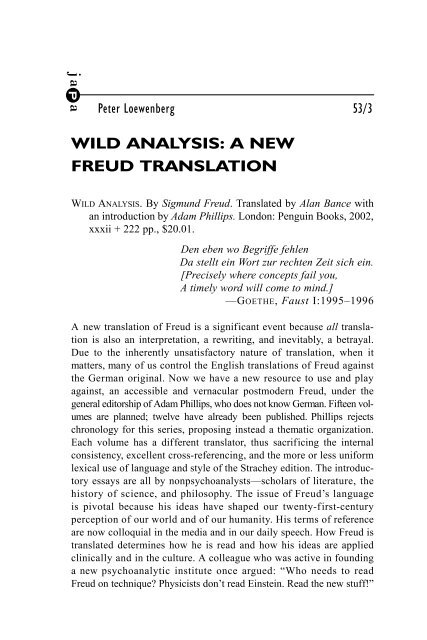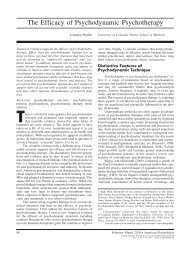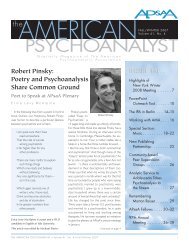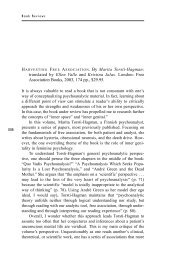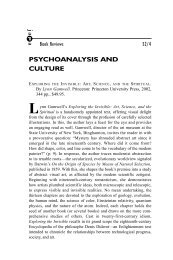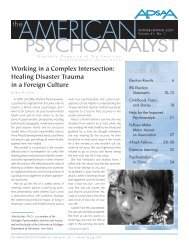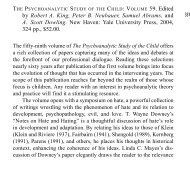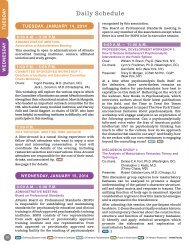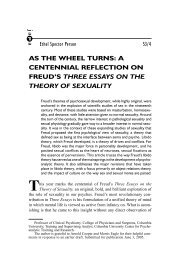WILD ANALYSIS: A NEW FREUD TRANSLATION ja a - American ...
WILD ANALYSIS: A NEW FREUD TRANSLATION ja a - American ...
WILD ANALYSIS: A NEW FREUD TRANSLATION ja a - American ...
You also want an ePaper? Increase the reach of your titles
YUMPU automatically turns print PDFs into web optimized ePapers that Google loves.
<strong>ja</strong>p a<br />
Peter Loewenberg 53/3<br />
<strong>WILD</strong> <strong>ANALYSIS</strong>: A <strong>NEW</strong><br />
<strong>FREUD</strong> <strong>TRANSLATION</strong><br />
<strong>WILD</strong> <strong>ANALYSIS</strong>. By Sigmund Freud. Translated by Alan Bance with<br />
an introduction by Adam Phillips. London: Penguin Books, 2002,<br />
xxxii + 222 pp., $20.01.<br />
Den eben wo Begriffe fehlen<br />
Da stellt ein Wort zur rechten Zeit sich ein.<br />
[Precisely where concepts fail you,<br />
A timely word will come to mind.]<br />
—GOETHE, Faust I:1995–1996<br />
A new translation of Freud is a significant event because all translation<br />
is also an interpretation, a rewriting, and inevitably, a betrayal.<br />
Due to the inherently unsatisfactory nature of translation, when it<br />
matters, many of us control the English translations of Freud against<br />
the German original. Now we have a new resource to use and play<br />
against, an accessible and vernacular postmodern Freud, under the<br />
general editorship of Adam Phillips, who does not know German. Fifteen volumes<br />
are planned; twelve have already been published. Phillips rejects<br />
chronology for this series, proposing instead a thematic organization.<br />
Each volume has a different translator, thus sacrificing the internal<br />
consistency, excellent cross-referencing, and the more or less uniform<br />
lexical use of language and style of the Strachey edition. The introductory<br />
essays are all by nonpsychoanalysts—scholars of literature, the<br />
history of science, and philosophy. The issue of Freud’s language<br />
is pivotal because his ideas have shaped our twenty-first-century<br />
perception of our world and of our humanity. His terms of reference<br />
are now colloquial in the media and in our daily speech. How Freud is<br />
translated determines how he is read and how his ideas are applied<br />
clinically and in the culture. A colleague who was active in founding<br />
a new psychoanalytic institute once argued: “Who needs to read<br />
Freud on technique Physicists don’t read Einstein. Read the new stuff!”
Peter Loewenberg<br />
I responded that I am not sure he is correct about physicists, but what<br />
better would you have students in psychoanalysis read on the dynamics<br />
of transference than Freud’s brief lucid early papers on technique<br />
These are the papers that Phillips chose for the first volume of this<br />
new Penguin Classics edition.<br />
Over three decades ago Kurt Eissler (1971) elegantly made the<br />
point that Freud’s genius is primarily linguistic:<br />
A psychological explication of Freud’s genius will, I think, have to<br />
center in his language. . . . I even anticipate the possibility that one day<br />
someone will be able to demonstrate that what Freud presented to<br />
the world in the organized form of his scientific papers—which seem<br />
to contain the results of innumerable as well as of single observations,<br />
of intensive meditation and deliberations, of subtle working through,<br />
checking and counterchecking, comparing and returning over and over<br />
again to the raw observational data that all this was in the end the refined<br />
and scientifically correct presentation of what had been linguistically<br />
performed earlier [p. 277].<br />
974<br />
Paul Ricoeur (1977) invites us “to reflect upon the concept of<br />
narrative intelligibility which psychoanalysis has in common with the<br />
historical sciences” (p. 861). “In psychoanalysis the means of proof<br />
reside in the very articulation of the entire network constituted by<br />
theory, the interpretive procedures, the therapeutic treatment, and the<br />
narrative structure of the analytic experience” (p. 865). Freud’s view on<br />
psychoanalytic education also emphasizes the flexibility of a narrative<br />
rehearsal: “The whole thing demands a certain measure of freedom of<br />
movement and will not tolerate petty restrictions” (Freud 1926; my<br />
translation); “Das Ganze erfordert aber ein gewisses Mass von<br />
Bewegungsfreiheit und verträgt keine kleinlichen Beschränkungen”<br />
(Studienausgabe, Ergänzungsband, S. 339; hereafter Stud., Erg.).<br />
All anglophone psychoanalysts and writers who have studied Freud<br />
have been nurtured on James Strachey’s Standard Edition (SE). The<br />
Strachey translation, comprising some two million words, is magisterial,<br />
but it is also, as noted on publication, and as decades of scholarship<br />
and critique have demonstrated, seriously flawed. The tension and<br />
contradictions inherent in Strachey’s aim as a translator are implicit in<br />
his “General Preface” (1966) to the edition. Strachey recognized that<br />
“Freud was a striking example of a man equally at home in both of what<br />
have been called the ‘two cultures’. . . . he was also widely read in the<br />
Greek and Latin classics as well as in the literatures of his own lan-
A <strong>NEW</strong> <strong>FREUD</strong> <strong>TRANSLATION</strong><br />
guage and in those of England, France, Italy and Spain” (p. xvi). Yet<br />
Strachey made clear that his fantasied reader was explicitly culture,<br />
time, and class specific: “The imaginary model I have always kept<br />
before me is the writings of some English man of science of wide education<br />
born in the middle of the nineteenth century. And I should like,<br />
in an explanatory and no patriotic spirit, to emphasize the word<br />
‘English’ ” (p. xix). Strachey was avowedly translating for a Victorian<br />
gentleman, a Charles Darwin (1809–1882), Francis Galton (1822–<br />
1911), or Thomas Huxley (1825–1895). For good reason the Strachey<br />
edition is referred to with awe and disparagement as “the King James<br />
Version.” John Forrester characterized it as “a cross between Thomas<br />
Hardy and Julian Huxley” (quoted in Merkin 2003, p. 43).<br />
Although he was familiar with the classical languages, Freud rarely<br />
gave his concepts Greek and Latin names. He preferred ordinary spoken<br />
German and occasionally modern English or French. Strachey,<br />
of Cambridge and Bloomsbury, Latinized and Hellenized Freud’s<br />
vigorous, often colloquial, German. As Bettelheim (1983) polemically<br />
but usefully pointed out, in the Standard Edition the word Besetzung<br />
needlessly became Hellenized as cathexis when it more accurately<br />
should be occupies; Abwehr became defence when it could better have<br />
been fending off or parrying; Fehlleistung became a combination of<br />
Greek words, parapraxis, when a more correct and smoother usage<br />
for the reader would be lapse or slip (pp. 84–91). D. J. Fisher (2005)<br />
persuasively argues that “Freud’s language was explicitly chosen to<br />
sound an intimate note, . . . he built theory in order to strike his audience’s<br />
private register. . . . reading Freud ought to invite a process of<br />
familiarity, akin to the spontaneous, empathic feelings of closeness<br />
experienced in confronting the human in oneself” (p. 35).<br />
Freud’s humanistic language was given a positivistic, empiricist,<br />
nineteenth-century natural science turn by Strachey: geisteswissenschaftlichen<br />
Stoff and Geisteswissenschaft (Stud., Erg., Ss. 343, 348) are<br />
widely used and well known in the germanophone world to mean<br />
humanistic science. These strategic terms fully lose the distinction<br />
between humanism and natural science when they are mistranslated<br />
by Strachey as the mental sciences (SE 20:252, 257). This is no coincidence:<br />
the emotional nuances, the kinesthetic, imagistic, and metaphorical<br />
quality of the unconscious, are lost when analysis becomes a<br />
dispassionate, mechanistic scientific project to objectively distance and<br />
dissect. Strachey’s apparent intent was to transform psychoanalysis<br />
975
Peter Loewenberg<br />
from a hermeneutic of emotions to a medico-biological natural science<br />
with rigidly fixed structures. As Marjorie Brierley (1965) noted in<br />
her critique upon the publication of the Standard Edition,<br />
On occasion the psychic systems have been treated as far too rigid<br />
entities. But these systems are organizations of living processes, which<br />
can have more or less enduring patterns but no structure in the<br />
architectural sense. Structure, used of the psyche, is a metaphor. . . .<br />
Clearly, if the psychic organizations were rigid, unmodifiable ‘‘structures”<br />
Freud’s summary of the aim of therapy ‘‘Where id was, there ego<br />
shall be’’ could have no meaning [pp. 253–253].<br />
976<br />
Freud’s models of the mind were, as Ornston (1985) says, “his way of<br />
imagining what goes on unconsciously” (p. 408).<br />
Freud never limited the scope of psychoanalysis to being a subspecialty<br />
of psychiatry. As translator Alan Bance writes, “His vision of<br />
psychoanalysis extending into all realms of cultural and intellectual life<br />
has been realized” (p. xxxii). The Phillips/Bance version is modern in<br />
its translation of Freud’s suggestive and very contemporary technological<br />
metaphor for listening to the unconscious: “Er soll dem gebenden<br />
Unbewussten des Kranken sein eigenes Unbewusstes als empfangendes<br />
Organ zuwenden, sich auf den Analysierten einstellen wie der Receiver<br />
des Telephons zum Teller eingestellt ist” (Stud., Erg., S. 339). Strachey<br />
translates this as “he must turn his own unconscious like a receptive<br />
organ towards the transmitting unconscious of the patient. He must<br />
adjust himself to the patient as a telephone receiver is adjusted to the<br />
transmitting microphone” (SE 12:115–116). Phillips/Bance uses attachment<br />
theory idioms: “attuning himself to the analysand as the receiver<br />
of a telephone is attuned to the disc” (p. 37). The Phillips/Bance translation<br />
deliberately invokes the current clinical language of empathic<br />
attunement. Freud often used figures of speech and expressions derived<br />
from military combat to capture active kinesthetic images of the clinical<br />
struggle with neurosis. The feeling tone and the psychodynamics<br />
in Freud’s original terms are important because the connotations<br />
convey a dynamic rather than a passive concept, which has been distorted<br />
in translation. In war Verdrängung is the active dislodging of<br />
the enemy. In nautical engineering it means the vessel’s displacement<br />
of water. “Repression” suggests a direction, holding something down.<br />
Freud (1915) explicitly stressed that repression implies no direction:<br />
“ihr Wesen nur in der Abweissung und Fernhaltung vom Bewusstsen<br />
besteht”; “its essence lies only in dismissal and keeping at a distance
A <strong>NEW</strong> <strong>FREUD</strong> <strong>TRANSLATION</strong><br />
from the conscious” (Stud., III, 108; my translation). In Strachey’s<br />
passive voice, this becomes: “the essence of repression lies simply in<br />
turning something away, and keeping it at a distance, from the conscious”<br />
(SE 14:147). Freud’s vigorous kinesthetic injunction of how<br />
to handle the analysand’s refusal to free associate is in the military<br />
idiom of a resistance that has moved to the front and must be physically<br />
struck down: “Ein starker Widerstand is da in die Front gerückt,<br />
um die Neurose zu verteidigen; man nehme die Herausforderung sofort<br />
an und rücke ihm an den Leib” (Stud., Erg., S. 197). Strachey softly<br />
says “come to grips with it” (SE 12:137). Phillips/Bance is more faithful<br />
to the original when it expresses it as “move in for close combat”<br />
(p. 57). When Freud talked of his concern about the dominance of<br />
therapy over science in psychoanalysis he used erschlägt (Stud.,<br />
Erg., S. 345), a powerful irregular intransitive verb meaning beaten to<br />
death in personal combat, war, or adversarial fighting such as litigation.<br />
Strachey softens this to “therapy will not destroy the science”<br />
(SE 20:254). Phillips/Bance is closer to the immediacy of combat, but<br />
still kinesthetically distant, with “the therapy should be prevented from<br />
killing off the science” (p. 166).<br />
It is a daunting challenge to translate Freud’s unpretentious,<br />
sometimes earthy, vigorous language and the pungency of his imagery.<br />
Strachey covers Freud’s immediacy with gentility. Phillips/Bance<br />
regains some of Freud’s direct colloquial simplicity. In writing of an<br />
impaired I (Ego), which Freud here concretizes and personifies, he<br />
says it is as though the I were walking through unfamiliar terrain and is<br />
nicht rüstig, meaning not hearty or strong (Stud., Erg., S. 377). Strachey<br />
makes this “without having a good pair of legs” (SE 23:237).<br />
Phillips/Bance turns this to “are not very sprightly on your legs”<br />
(p. 193). Freud held that a single wrong interpretation was harmlos<br />
(Stud., Erg., S. 399). Strachey made this “can do no harm” (SE 23:237).<br />
Phillips/Bance simply restores “harmless” (p. 215). When Freud writes<br />
of the analysand’s unconscious tactic of dividing the treatment into an<br />
official therapeutic “work” part and an informal “chat” portion in which<br />
patients speak freely and disclose many things which they regard as<br />
not part of the analysis, he uses the common German expression<br />
gemütlichen (Stud., Erg., S.198). Strachey translates gemütlich as “informal”<br />
or “friendly” (SE 12:139), but Phillips/Bance uses an appropriate<br />
colloquial English “cosy” (p. 59).Strachey regularly alters Freud’s<br />
immediacy of the present tense to the weaker past tense. Freud wrote<br />
977
Peter Loewenberg<br />
978<br />
about childhood repression using an irregular intransitive verb: “die<br />
entscheidenden Verdrängungen vorgefallen sind” (Stud., Erg., S. 300);<br />
in Strachey this becomes passive: “the decisive repressions have taken<br />
place then . . .” (SE 20:209). Thus, what Freud describes as a dynamic<br />
process becomes a structure in Strachey. Phillips/Bance restores Freud’s<br />
active voice: “the decisive repressions occur” (p. 118).<br />
In some cases the Strachey translation is literally more accurate, a<br />
critical value for scholarship. Freud’s discussion of those lay persons<br />
who place feelings of love on an idealized besonderen Blatte (Stud.,<br />
Erg., S. 219) is accurately “special page” in Strachey (SE 12:160) and<br />
more elegantly “a special parchment” in Phillips/Bance (p. 68). Freud’s<br />
direct and forceful German banalen Unlustgefühles (Stud., Erg., S.<br />
161, n.1) becomes “ordinary feelings of unpleasure” in Strachey (SE<br />
12:101, n.1) and a looser, less accurate, but more colloquial “trivial<br />
feeling of unwillingness” in Phillips/Bance (p. 29, n.4). What Freud<br />
termed der Zeitlosigkeit und der Halluzinationsfähigkeit des<br />
Unbewussten (Stud., Erg., S.167) is accurately translated by Strachey<br />
as “The timelessness of the unconscious and its capacity for hallucination”<br />
(SE 12:108). In Phillips/Bance this awkwardly becomes<br />
“the ‘time-free’ nature and the hallucinatory power of the unconscious”<br />
(p. 28).<br />
A translation can never be more than an approximation. We must<br />
acknowledge that there is no “true” Freud. Each generation will retranslate<br />
and reinterpret these texts in accord with its age, needs, and<br />
experience. As Daniel Lagache (1967) argued, “words, like ideas (and<br />
together with ideas), are not merely created—they have a fate: they may<br />
fall into disuse or lose their currency, giving way to others which are<br />
better suited to the needs of fresh orientations in research and theory”<br />
(p. viii). Our historical, cultural, and psychoanalytic moment is radically<br />
different from that of Strachey half a century ago. Freud occupies<br />
a pivotal position in the contemporary humanist cultural hermeneutic<br />
canon. We need a Freud who speaks directly to us and to our time. The<br />
Phillips/Bance Freud is more cultural, literary, historical, and anthropological,<br />
and less committed to establishing the positivistic empirical<br />
scientific validity of psychoanalysis, than was the Strachey edition.<br />
This new translation of Freud is welcome because it offers, to clinicians,<br />
general informed readers, students, and researchers, new<br />
options—in this case, colloquial ordinary English truer to Freud’s<br />
direct ordinary German—and is more attuned to contemporary psycho-
A <strong>NEW</strong> <strong>FREUD</strong> <strong>TRANSLATION</strong><br />
analytic theoretical and clinical concerns and usage. Unfortunately,<br />
the utility of the new translation is substantially weakened by the<br />
absence of an index.<br />
REFERENCES<br />
BETTELHEIM, B. (1983). Freud and Man’s Soul. New York: Knopf.<br />
BRANDT, L.W. (1961). Some notes on English Freudian terminology, Journal<br />
of the <strong>American</strong> Psychoanalytic Association 9:331–339.<br />
BRIERLEY, M. (1965). Review of SE XIX and XXII. International Journal<br />
of Psychoanalysis 46:251–254.<br />
EISSLER, K. (1971). Talent and Genius: The Fictitious Case of Tausk contra<br />
Freud. New York: Quadrangle Books.<br />
FISHER, D.J. (2005). Bettelheim: Living and Dying. Unpublished manuscript.<br />
<strong>FREUD</strong>, S. (1915). Die Verdrängung. Studienausgabe III. Frankfurt am Main:<br />
S. Fischer Verlag, 1975.<br />
——— (1926). Die Frage der Laienanalyse. Studienausgabe, Ergänzungsband,<br />
271–341. Frankfurt am Main: S. Fischer Verlag, 1975.<br />
LAGACHE, D. (1967). Introduction: The origins and history of this work.<br />
In J. Laplanche & J.-B. Pontalis, The Language of Psycho-Analysis,<br />
transl. D. Nicholson-Smith. New York: Norton, 1973, pp. vii–ix.<br />
MERKIN, D. (2003). The literary Freud. New York Times Magazine, July 13,<br />
2003, pp. 40–44.<br />
ORNSTON, D. (1985). Freud’s conception is different from Strachey’s.<br />
Journal of the <strong>American</strong> Psychoanalytic Association 33:379–412.<br />
RICOEUR, P. (1977). The question of proof in Freud’s psychoanalytic writings.<br />
Journal of the <strong>American</strong> Psychoanalytic Association 25:835–871.<br />
STRACHEY, J. (1966). General preface. Standard Edition of the Complete<br />
Psychological Works of Sigmund Freud, ed. J. Strachey. London:<br />
Hogarth Press, vol. 1, pp. xiii–xxi.<br />
979<br />
Peter Loewenberg<br />
449 Levering Avenue<br />
Los Angeles, CA 90024–1909<br />
Fax: 310–471–0048<br />
E-mail: ibenaub@mvs.oac.ucla.edu


